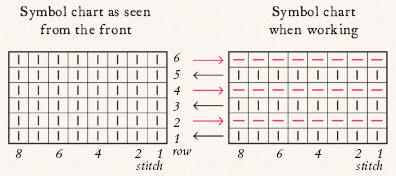

Symbol
see also Knitting Chart Symbols
Knitting - Basic Techniques
The basic knit fabrics—stockinette stitch, garter stitch, and rib stitch—are made by combining knit-stitches and purl-stitches. Knitting instructions are often given as symbol charts, so learning to read a chart is important.
Reading a symbol chart
A symbol chart shows the arrangement of stitches as seen from the front (right side) of the completed fabric. Look at the symbol chart for knitting back and forth in rows while working stockinette stitch. Note: Knitting in rows means working a row in pattern, turning, then working the alternate row in pattern; for stockinette stitch this means knit a right-side row, turn, purl the wrong-side row, turn.
 |
According to the charts, rows worked with the right-side facing (Rows 1, 3, and 5) are worked as knit-stitches, as shown by the symbols, rows worked with the wrong-side facing (Rows 2, 4, and 6) are worked as purl-stitches. |
|
|
Garter stitch For a fabric that looks like alternating rows of knit and purl stitches, knit every row. Both sides look the same. Because the edges of the fabric don’t roll up, it’s suitable for edgework, scarves, necklines, etc. |
 |
Stockinette (or
stocking) stitch When working back and forth in rows, stockinette stitch is worked by alternating knit-stitches and purl-stitches every other row; in circular knitting (see page 10), knit-stitch is worked every round. The right side and wrong side of this fabric can be clearly distinguished. A surface with all knit-stitches facing is called stockinette stitch, and a surface with all purl-stitches facing is called reverse stockinette stitch. The lower edges will roll up toward the knit-stitch side. |
